The NVIDIA GeForce GTX 650 Ti Review, Feat. Gigabyte, Zotac, & EVGA
by Ryan Smith on October 9, 2012 9:00 AM ESTCompute Performance
As always our final set of real-world benchmarks is composed of a look at compute performance. As we have seen with GTX 680 other Kepler cards, Kepler appears to be significantly less balanced between rendering and compute performance than GF110 or GF114/GF116 were, and as a result compute performance suffers. On the other hand, relative to the GTX 660 the GTX 650 Ti sacrifices a smaller portion of its compute performance than its ROP/L2/memory performance, so this may bode better for computer performance.
Our first compute benchmark comes from Civilization V, which uses DirectCompute to decompress textures on the fly. Civ V includes a sub-benchmark that exclusively tests the speed of their texture decompression algorithm by repeatedly decompressing the textures required for one of the game’s leader scenes. Note that this is a DX11 DirectCompute benchmark.
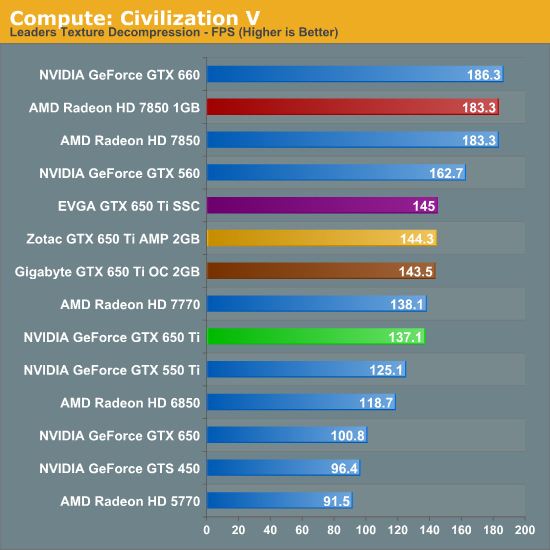
There really isn’t a lot to say here. The GTX 650 Ti is only slightly ahead of the GTX 550 Ti, never mind the GTX 560. Worse, it’s tied with the 7770 and well behind the 7850. Given the nature of the test, with cards on memory busses this small I believe we’ve run into a proxy test for memory bandwidth rather than compute throughput. Which just goes to show that all of that compute throughput is meaningless without the memory bandwidth and cache to feed the best.
Our next benchmark is SmallLuxGPU, the GPU ray tracing branch of the open source LuxRender renderer. We’re now using a development build from the version 2.0 branch, and we’ve moved on to a more complex scene that hopefully will provide a greater challenge to our GPUs.
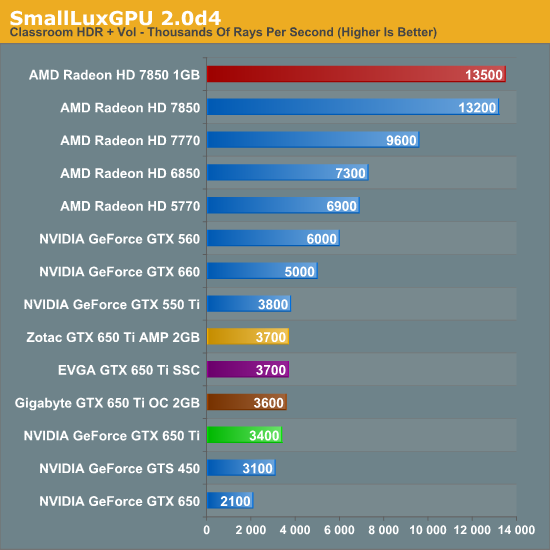
Not surprisingly, the GTX 650 Ti loses to just about everything. SmallLuxGPU’s OpenCL renderer just doesn’t mesh well with Kepler and NVIDIA’s drivers. The resulting lead for the 7850 is nothing short of massive.
For our next benchmark we’re looking at AESEncryptDecrypt, an OpenCL AES encryption routine that AES encrypts/decrypts an 8K x 8K pixel square image file. The results of this benchmark are the average time to encrypt the image over a number of iterations of the AES cypher.
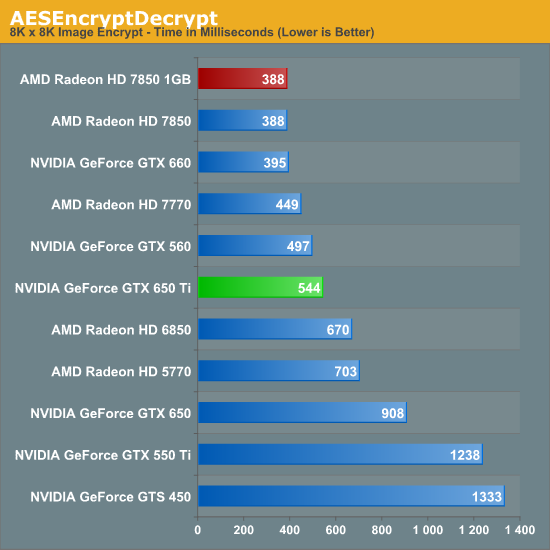
Unlike our previous OpenCL benchmark the GTX 650 Ti’s showing isn’t nearly as bad, but neither is it great. Both the GTX 560 and the 7770 are in the lead, but at least the improvement over the GTX 550 Ti is nothing short of amazing. At times NVIDIA’s problem isn’t where GTX 650 Ti is compared to last-generation cards, but rather it is compared to AMD’s strong Radeon HD 7000 series lineup.
Our fourth benchmark is once again looking at compute shader performance, this time through the Fluid simulation sample in the DirectX SDK. This program simulates the motion and interactions of a 16k particle fluid using a compute shader, with a choice of several different algorithms. In this case we’re using an (O)n^2 nearest neighbor method that is optimized by using shared memory to cache data.
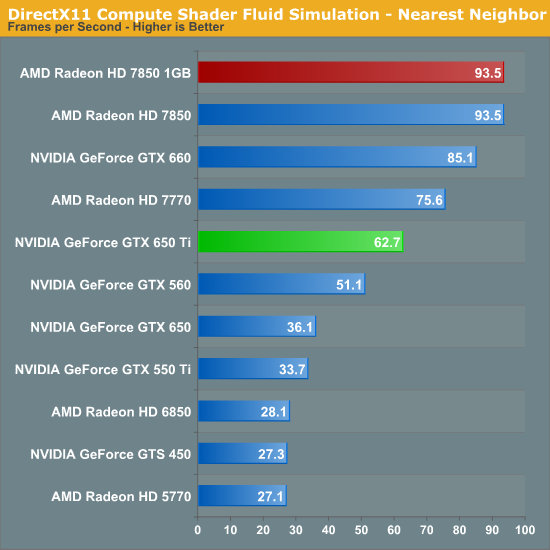
Once more the GTX 650 Ti is in trouble. It can beat the GeForce 500 series, but even the 7770 is faster.
Finally, we’ll take a look at one last benchmark to our compute run with the benchmarkable version of the Folding@Home client. Folding@Home and similar initiatives are still one of the most popular consumer compute workloads, so it’s something NVIDIA wants their GPUs to do well at.
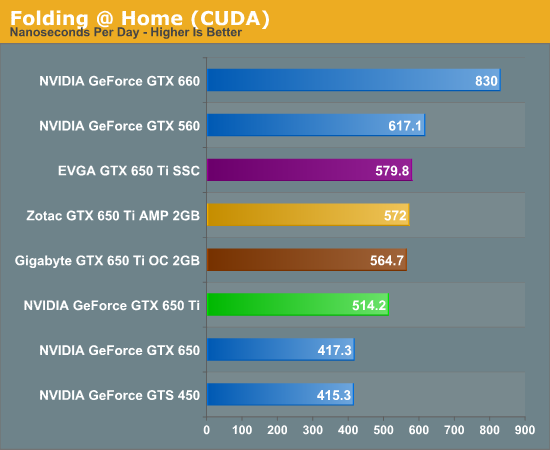
Here’s another case where memory bandwidth and L2 cache appear to be a problem. The GTX 650 Ti is much farther behind the GTX 660 than we would have expected, and even the GTX 560 can take a lead here. On the other hand memory bandwidth bottlenecking isn’t so bad that EVGA’s GTX 650 Ti can’t still take the lead over the other factory overclocked cards.










91 Comments
View All Comments
TheJian - Tuesday, October 9, 2012 - link
The 7850 is more money, it should perform faster. I'd expect nothing less. So what this person would end up with is 10-20% less perf (in the situation you describe) for 10-20% less money. ERGO, exactly what they should have got. So basically a free copy of AC3 :) Which is kind of the point. The 2GB beating the 650TI in that review is $20 more. It goes without saying you should get more perf for more $. What's your point?Your wrong. IN the page you point to (just looking at that, won't bother going though them all), the 650TI 1GB scores 32fps MIN, vs. 7770 25fps min. So unplayable on 7770, but playable on 650TI. Nuff said. Spin that all you want all day. The card is worth more than 7770. That's OVER 20% faster 1920x1080 4xAA in witcher 2. You could argue for $139 maybe, but not with the AC3 AAA title, and physx support in a lot of games and more to come.
http://www.geforce.com/games-applications/physx
All games with physx so far. Usually had for free, no hit, see hardocp etc. Borderlands 2, Batman AC & AAsylum, Alice Madness returns, Metro2033, sacred2FA, etc etc...The list of games is long and growing. This isn't talked about much, nor what these effects at to the visual experience. You just can't do that on AMD. Considering these big titles (and more head to the site) use it, any future revs of these games (sequels etc) will likely use it also and the devs now have great experience with physx. This will continue to become a bigger issue as we move forward. What happens when all new games support this, and there's no hit for having it on (hardocp showed they were winning WITH it on for free)? There's quite a good argument even now that a LOT of good games are different in a good way on NV based cards. Soon it won't be a good argument, it will be THE argument. Unfortunately for AMD/Intel havok never took off and AMD has no money to throw at devs to inspire them to support it. NV continues to make games more fun on their hardware (either on android tegrazone stuff, or PC stuff). Much tighter connections with devs on the NV side. Money talks, unfortunately for AMD debt can't talk for you (accept to say don't buy my stock we're in massive debt) :)
jtenorj - Wednesday, October 10, 2012 - link
No, you are wrong. Lower end nvidia cards(whether this card falls into that category or not is debatable) generally cannot run physx on high, but require it to be set to medium, low or off. AMD cards can run physx in a number of games on medium by using the cpu without a massive performance hit. There hasn't been a lot of time since nvidia got physx tech from ageia for game developers to include it in titles because developement cycles are getting longer and longer. Still, I think most devs shy away from physx because it hurts the bottom line(more time to impliment= more money spend on salaries and later release, alienate 40% of potential market by making it so the full experience is not an option for them, losing more money). Take a look at the havok page on wikipedia vs the physx page(which is more extensive than what even nvidia lists on their own site). Havok and other software physics engines are used in the vast majority of released and soon to be released titles because they will work with anyone's card. I'm not saying HD7770 is better than gtx650ti(it is in fact worse than the new card), but the HD7850 is a far better value(especially the 2GB version). Finally, it is possible to add a low end geforce like gt610 to a higher end AMD primary as a dedicated physx card in some systems.ocre - Thursday, October 11, 2012 - link
but it doest alienate 40% of the market.You said this yourself:
"AMD cards can run physx in a number of games on medium by using the cpu without a massive performance hit."
Then try to turn it all around???? Clever? Doubtful!!
And this is what all the AMD fanboys cried about. Nvidia purposefully crippling physX on the CPU. Nvidia evil for making physX nvidia only. But now they have improved their physX code on the CPU and every single game as of late offers acceptable physX performance on AMD hardware via the CPU. Of course you will only get fully fledged GPU accelerated physX with Nvidia hardware but you cannot really expect more, can you?
Even if your not capable of seeing the improvements Nvidia made it is there. They have reached over and extended the branch to AMD users. They got physX to run better on multicore CPUs. They listened to complaints (even from AMD users) and made massive improvements.
This is the thing with nvidia. They are listening and steadily improving. Removing those negatives one at a time. Its gonna be hard for AMD fanboys to come up with negatives because nvidia is responding with every generation. PhysX is one example, the massive power efficiency improvement of kepler is another. Nvidia is proactive and looking for ways to improve their direction. All these things complaints on Nvidia are getting addressed. There is nothing you can really say except they are making good progress. But that will not stop AMD fans from desperately searching for any negative that they can grasp on to. But more and more people are taking note of this progress, if you havent noticed yourself.
CeriseCogburn - Friday, October 12, 2012 - link
Oh, so that's why the crybaby amd fans have shut their annoying traps on that, not to mention their holy god above all amd/radeon videocards apu holy trinity company after decades of foaming the fuming rage amd fanboys into mooing about "proprietary Physx! " like a sick monkey in heat and half dead, and extolling the pure glorious god like and friendly neighbor gamer love of "open source" and spewwwwwwwing OpenCL as if they had it sewed all over their private parts and couldn't stop staring and reading the teleprompter, their glorious god amd BLEW IT- and puked out their proprietary winzip !R O F L
Suddenly the intense and insane constant moaning and complaining and attacking and dissing and spewing against nVidia "proprietary" was gone...
Now "winzip" is the big a compute win for the freak fanboy of we know which company. LOL
P R O P R I E T A R Y ! ! ! ! ! ! ! ! ! ! 1 ! 1 100100000
JC said it well : Looooooooooooooooooooooseeerrrr !
(that's Jim Carey not the Savior)
CeriseCogburn - Friday, October 12, 2012 - link
" You buy a GPU to play 100s of games not 1 game. "Good for you, so the $50 games times 100 equals your $5,000.00 gaming budget for the card.
I guess you can stop moaning and wailing about 20 bucks in a card price now, you freaking human joke with the melted amd fanboy brain.
Denithor - Tuesday, October 9, 2012 - link
Hopefully your shiny new GTX 650 Ti will be able to run AC3 smoothly...:D
chizow - Thursday, October 11, 2012 - link
According to Nvidia, the 650Ti ran AC3 acceptably at 1080p with 4xMSAA on Medium settings: http://www.geforce.com/whats-new/articles/nvidia-g..."In the case of Assassin’s Creed III, which is bundled with the GTX 650 Ti at participating e-tailers and retailers, we recorded 36.9 frames per second using medium settings."
That's not all that surprising to me though as the GTX 280 ran AC2/ACB Anvil engine games at around the same framerate. While AC3 will certainly be more demanding, the 650Ti is a good bit faster than the 280.
I'm not in the market though for a GTX 650Ti, I'm more interested in the AC3 bundle making its way to other GeForce parts as I'm interested in grabbing another 670. :D
HisDivineOrder - Tuesday, October 9, 2012 - link
Perhaps you might test without AA when dealing with cards in a sub-$200 price range as that would seem the more likely use for the card. Not saying you can't test with AA, too, but to have all tests include AA seems to be testing a new Volkswagon bug with a raw speed test through a live fire training exercise you'd test a humvee with.RussianSensation - Tuesday, October 9, 2012 - link
AA testing is often used to stress the ROP and memory bandwidth of GPUs. Also, it's what separates consoles from PCs. If a $150 GPU cannot handle AA but a $160-180 competitor can, it should be discussed. When GTX650Ti and its after-market versions are so closely priced to 7850 1GB/7850 2GB, and it's clear that 650Ti is so much slower, the only one to blame here is NV for setting the price at $149, not the reviewer for using AA.GTX560/560Ti/6870/6950 were all tested with AA and this card not only competes against HD7850 but gives owners of older cards a perspective of how much progress there has been with new generation of GPUs. Not using AA would not allow for such a comparison to be made unless you dropped AA from all the cards in this review.
It sounds like you are trying to find a way to make this card look good but sub-$200 GPUs are capable of running AA as long as you get a faster card.
HD7850 is 34% faster than GTX650Ti with 4xAA at 1080P and 49% faster with 8xAA at 1080P
http://www.computerbase.de/artikel/grafikkarten/20...
All that for $20-40 more. Far better value.
Mr Perfect - Tuesday, October 9, 2012 - link
I thought GTX was reserved for high end cards, with lower tier cards being GT. I guess they gave up on that?